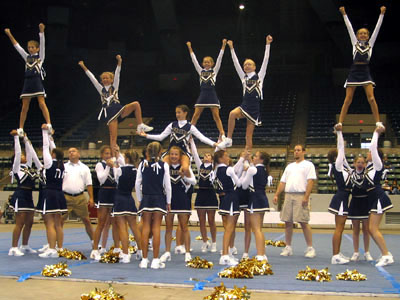JACKSON, Miss.—Rebecca Coward was beaming as she took the floor to compete in the cheerleading competition at the Mississippi State Fair.
Anyone watching would have never guessed she is still in therapy for wrist problems that have sidelined her much of this year. Because of her continuing recovery she had to avoid stunting or tumbling, but she said she didn’t mind.
“It felt great. I haven’t really been able to compete all year, so it was really exciting to be out there,” Coward, of Rankin County, said. Coward underwent surgery on both her wrists in July at Methodist Rehabilitation Center in Jackson. She is currently in physical therapy and hopes to be tumbling with her squad in the coming months.
There are 3.8 million cheerleaders in the U.S., up from three million in 1990. There were an estimated 146,000 emergency room visits annually related to gymnastics and cheerleading in 1997 and 1998, the most recent data available from the National Center for Health Statistics at the Centers for Disease Control and Prevention.
That’s less than football related injuries, which come in at 250,000 visits a year, but more than soccer, at 100,000 and a close second to ice or roller skating and skateboarding, at 150,000 emergency room visits a year.
As cheerleading becomes more and more popular and competitive, some local medical professionals say they have noticed an increase in injuries related to the sport.
Pam Joyner, an occupational therapist at Methodist’s outpatient clinic in Flowood, said many of the cases she deals with are girls who have developed wrist or finger problems related to cheerleading.
Coward has a physical tendency toward this type of injury because she is what is commonly referred to as “double jointed,” meaning her joints are more flexible than normal. But it’s not uncommon to see over use injuries in cheerleaders, said Dr. William Geisler, the University of Mississippi Medical Center orthopedic surgeon, who repaired torn ligaments in both of Coward’s wrists. “We see more wrist injuries in cheerleaders than anything else,” he said.
Joyner said overuse injuries are a difficult thing to avoid, considering the nature of the sport.
“It’s very repetitive. They often have one routine they learn for competition and they spend hours doing it over and over,” Joyner said.
That was the scene in the Mississippi Coliseum as squads from around the state performed dance routines and cheers they have worked on for months.
Coward’s squad, the Champs for Christ from Tumble Cheer USA in Brandon, took first place in the Senior All-Star Division. Coward said it’s worth all the hard work and rehabilitation because it’s what she always wanted to do. She recently quit her high school squad to join the Champs for Christ.
“I thought it was a good way to combine two things I love—cheerleading and sharing the word of God,” she said.
Doug Burnett, one of the squad’s coaches, said cheerleading is like any other sport, there is always the risk of injury, especially at the competitive level of the select squads. But there are ways to minimize the risks, he said. “We don’t see a lot of injuries. We make sure they have the proper training, the proper matting or spring floors. We are very careful with our spotting and we do a lot of conditioning and strengthening. That’s really key – lot’s of conditioning.”

